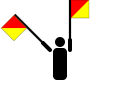T
| ISO basic Latin alphabet |
|---|
| AaBbCcDdEeFfGgHhIiJjKkLlMmNnOoPpQqRrSsTtUuVvWwXxYyZz |
T, or t, is the twentieth letter of the Latin alphabet, used in the modern English alphabet, the alphabets of other western European languages and others worldwide. Its name in English is tee (pronounced /ˈtiː/ ⓘ), plural tees.
It is derived from the Semitic Taw 𐤕 of the Phoenician and Paleo-Hebrew script (Aramaic and Hebrew Taw ת/𐡕/![]() , Syriac Taw ܬ, and Arabic ت Tāʼ) via the Greek letter τ (tau). In English, it is most commonly used to represent the voiceless alveolar plosive, a sound it also denotes in the International Phonetic Alphabet. It is the most commonly used consonant and the second-most commonly used letter in English-language texts.
, Syriac Taw ܬ, and Arabic ت Tāʼ) via the Greek letter τ (tau). In English, it is most commonly used to represent the voiceless alveolar plosive, a sound it also denotes in the International Phonetic Alphabet. It is the most commonly used consonant and the second-most commonly used letter in English-language texts.
History
Taw was the last letter of the Western Semitic and Hebrew alphabets. The sound value of Semitic Taw, the Greek alphabet Tαυ (Tau), Old Italic and Latin T has remained fairly constant, representing [t] in each of these, and it has also kept its original basic shape in most of these alphabets.
Use in writing systems
English
In English, ⟨t⟩ usually denotes the voiceless alveolar plosive (International Phonetic Alphabet and X-SAMPA: /t/), as in tart, tee, or ties, often with aspiration at the beginnings of words or before stressed vowels. The letter ⟨t⟩ corresponds to the affricate /t͡ʃ/ in some words as a result of yod-coalescence (for example, in words ending in -"ture", such as future).
A common digraph is ⟨th⟩, which usually represents a dental fricative, but occasionally represents /t/ (as in Thomas and thyme). The digraph ⟨ti⟩ often corresponds to the sound /ʃ/ (a voiceless palato-alveolar sibilant) word-medially when followed by a vowel, as in nation, ratio, negotiation, and Croatia.
In a few words of modern French origin, the letter T is silent at the end of a word; these include croquet and debut.
Other languages
In the orthographies of other languages, ⟨t⟩ is often used for /t/, the voiceless dental plosive /t̪/, or similar sounds.
Other systems
In the International Phonetic Alphabet, ⟨t⟩ denotes the voiceless alveolar plosive.
Other uses
- Unit prefix T, meaning 1,000,000,000,000 times.
Related characters
Descendants and related characters in the Latin alphabet

- T with diacritics: Ť ť Ṫ ṫ ẗ Ţ ţ Ṭ ṭ Ʈ ʈ Ț ț ƫ Ṱ ṱ Ṯ ṯ Ŧ ŧ Ⱦ ⱦ Ƭ ƭ ᵵ ᶵ
- Ꞇ ꞇ : Insular T, also used by William Pryce to designate the voiceless dental fricative [θ]
- ᫎ : Combining small insular t was used in the Ormulum
- ʇ : Turned small t is used in the International Phonetic Alphabet (IPA)
- 𐞯 : Modifier letter small t with retroflex hook is a superscript IPA letter
- 𝼉 : Latin small letter t with hook and retroflex hook is a symbol for a voiceless retroflex implosive
- 𝼍 : Latin small turned t with curl is a click letter
- Uralic Phonetic Alphabet-specific symbols related to T:
- U+1D1B ᴛ LATIN LETTER SMALL CAPITAL T
- U+1D40 ᵀ MODIFIER LETTER CAPITAL T
- U+1D57 ᵗ MODIFIER LETTER SMALL T
- U+1E97 ẗ LATIN SMALL LETTER T WITH DIAERESIS
- ₜ : Subscript small t was used in the Uralic Phonetic Alphabet prior to its formal standardization in 1902
- ȶ : T with curl is used in Sino-Tibetanist linguistics
- Ʇ ʇ : Turned capital T and turned small t were used in transcriptions of the Dakota language in publications of the American Board of Ethnology in the late 19th century.
- 𝼪 : Small t with mid-height left hook was used by the British and Foreign Bible Society in the early 20th century for romanization of the Malayalam language.
Ancestors and siblings in other alphabets
- 𐤕 : Semitic letter Taw, from which the following symbols originally derive:
- ፐ : One of the 26 consonantal letters of the Ge'ez script. The Ge'ez abugida developed under the influence of Christian scripture by adding obligatory vocalic diacritics to the consonantal letters. Pesa ፐ is based on Tawe ተ.
Derived signs, symbols and abbreviations
Other representations
Computing
Other
| NATO phonetic | Morse code |
| Tango | ⓘ |
 |  |  |  | |
| Signal flag | Flag semaphore | American manual alphabet (ASL fingerspelling) | British manual alphabet (BSL fingerspelling) | Braille dots-2345 Unified English Braille |
- The letter T in German Sign Language

